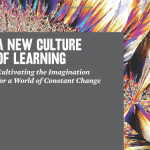The challenge after attending a two day conference is deciding which of the amazing, wonderful, innovative ideas that you are actually going to implement when you return to the reality of your life at school. Last week I had the opportunity to attend and to present at ECOO12, a provincial technology conference. I spent the first hour trying to get my head around the fact that I was surrounded by 700 participants who not only share my passion for technology but whom, for the most part, are far more adept at using new technologies than I am. I was proud of the fact that I was simultaneously using my Evernote app on my iPad to capture the nuggets that the presenters were sharing and using my iPhone to text message colleagues and maintain some connection with what was happening at school.
The keynote on the first day was John Seely Brown, the co-author of “A New Culture of Learning”. I found myself enthralled with his presentation, as he was sharing in a cohesive manner what I’ve started to understand as we, as a school staff, delve deeper into our use and understanding of how to incorporate technology into our teaching. For most of my administrative career, I’ve believed strongly that students need access to technology and that with access to technology students will improve. But how do I turn my belief into tangible results.
Brown effectively used his knowledge about emerging technologies and wove that into a discussion about how we need to allow our students to “tinker”, to build a sense of the world through play and that learning occurs through conversation. What resonated with me was more about how technologies can assist students in making learning a constant adventure, how technologies can play a major role in which social networking becomes the trajectory for making connections and how we need to appreciate that students need an equal dose of academics, peer relations and interests.
The implications of Brown’s keynote address and the components of his book are shaping how I think about what should be happening in classrooms. If learning NEEDS to be social, what should I hear as I go from classroom to classroom? If “tinkering” is acceptable, what should I see as I go from classroom to classroom? And if I believe those components to be important, how do I model that when working with a staff of educators?

